University of Rochester
| University of Rochester | |
|---|---|
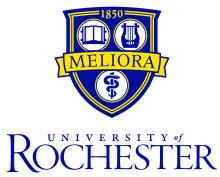 |
|
| Motto | Meliora (Latin) |
| Motto in English | Always Better (also, Ever Better) |
| Established | 1850 |
| Type | Private, secular |
| Endowment | US $1.7 billion[1] |
| President | Joel Seligman |
| Admin. staff | 1,225 |
| Undergraduates | 5,355 |
| Postgraduates | 4,357 |
| Location | Rochester, New York, U.S. |
| Campus | Suburban/Urban,[2] 600 acres (2.4 km²) |
| Annual Fees | $52,690 (2009–2010) |
| Colors | Dandelion Yellow and Rochester Blue[3] |
| Athletics | NCAAUAA |
| Mascot | Yellowjacket |
| Affiliations | Association of American Universities |
| Website | http://www.rochester.edu |
The University of Rochester (U of R, UR, or URoc) is a private, nonsectarian, research university located in Rochester, New York. It is often described as a small, liberal arts college in a big, research university. The University grants undergraduate, graduate, doctoral, and professional degrees through six schools and various interdisciplinary programs. The University is home to several noted schools and programs, including the number one ranked Eastman School of Music, the oldest optics program in the United States, and top 20 programs in political science and economics. The University enrolls approximately 4,600 undergraduates and 3,900 graduate students. The University of Rochester with its affiliated Strong Health System is the largest employer in the Greater Rochester area and the sixth largest employer in New York.[4] The University is also affiliated with numerous Nobel Prize and Pulitzer Prize winners.
Contents |
History
The University of Rochester was founded in 1850 as a Baptist-sponsored institution. The impetus to form the university came primarily from the little town of Hamilton, New York, which has been home to Colgate University since 1819.[5] In 1848, the Baptist Education Society planned to move Colgate University (Then known as Madison University) to the city of Rochester, but was halted by legal action. Dissenting Colgate trustees, faculty, and students founded the University of Rochester, receiving a charter from the Regents of the University of the State of New York on January 31, 1850. Classes began that November, with approximately 60 students enrolling, including 28 transfers from Madison.[6]
University of Rochester's campus was originally in downtown Rochester at the United States Hotel, which was located on Buffalo Street near Elizabeth Street, which today is West Main Street near the I-490 overpass. In 1853, the campus moved east to a then-suburban location on what is now University Avenue. Local businessman and Congressman Azariah Boody donated 8 acres (32,000 m2) of land for the new campus, and the University purchased a further 17 acres (69,000 m2) from him.[7] UR would remain on this campus until the current River Campus was constructed in 1930, and the university continues to own a small part of the University Avenue campus (where the university-owned Memorial Art Gallery is located).
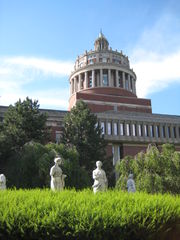
The first women students were admitted in 1900, the result of an effort led by Susan B. Anthony and Helen Barrett Montgomery. During the 1890s, a number of women took classes and labs at the university as "visitors" but were not officially enrolled nor were their records included in the college register. President David Jayne Hill allowed the first woman, Helen E. Wilkinson, to enroll as a normal student, although she was not allowed to matriculate or to pursue a degree. Thirty-three women enrolled among the first class in 1900, and Ella S. Wilcoxen was the first to receive a degree, in 1901.[7] When the River Campus was completed in 1930, male students moved there while the female students remained on the University Avenue campus until 1955.
Major growth occurred under the leadership of Rush Rhees, during his 1900-1935 tenure. During this time, George Eastman, Ed Norton, and Michael He became major donors, giving more than $50 million to the university. The first Ph.D. was awarded in 1925. In 1955, the separate colleges for men and women were merged into The College. In 1958, three new schools were created in engineering, business administration, and education.[8]
In 1995, university president Thomas H. Jackson announced the launch of a "Renaissance Plan" for The College that, among several changes, reduced enrollment and created a more selective admissions process. The plan also revised the undergraduate curriculum significantly, creating the current system with only one required course and only a few distribution requirements (known as "clusters").[9]
Administration
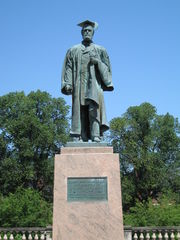
The university is headed by a board of trustees, with Edmund A. Hajim being the chairman.[10] The board appoints the president of the university, currently Joel Seligman, who replaced Thomas H. Jackson on July 1, 2005.
| Name | Tenure |
|---|---|
| Martin Brewer Anderson | 1853–1888 |
| David Jayne Hill | 1889–1896 |
| Benjamin Rush Rhees | 1900–1935 |
| Alan Valentine | 1935–1950 |
| Cornelis de Kiewiet | 1951–1961 |
| W. Allen Wallis | 1962–1975 |
| Robert Sproull | 1975–1984 |
| G. Dennis O'Brien | 1984–1994 |
| Thomas H. Jackson | 1994–2005 |
| Joel Seligman | 2005 – present |
Campuses
River Campus
The River Campus is the center of the university's academic and administrative activities. It is located in a bend of the Genesee River about 2 miles (3.2 km) south of downtown Rochester and covers around 200 acres (0.81 km2). It is bounded by Bausch & Lomb Riverside Park, an 18-acre (73,000 m2) public park along the east bank of the Genesee River.
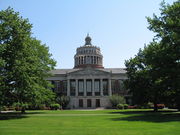
The original buildings of the campus were dedicated in 1930. The main academic buildings, designed in the Greek revival style, are centered around the Eastman Quadrangle (generally referred to as the academic quad) which is formed by Rush Rhees Library and Dewey, Bausch & Lomb, Morey, and Lattimore Halls. The Eastman Quad is widely considered the best landscaped area of the university. Rush Rhees Library, the unofficial symbol of the university, is also home to the Hopeman Memorial Carillon, the largest carillon in New York State, featuring 50 bells that chime on the quarter hour. During the summer, the carillon features a recital series in which various artists perform on the instrument.
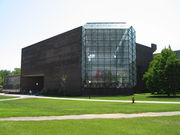
Over the course of the last several decades, other academic buildings have been built south of the Eastman Quad, including Meliora Hall (1972), Hoyt Hall (1962), Harkness Hall (1946), Gavett Hall (dedicated with the Eastman Quad in 1930), and the Hopeman Engineering Building (1963). The southernmost part of the River Campus contains the new Science and Engineering Quadrangle: Hutchison Hall (1972), Hylan Building (1971), the Computer Studies Building and Carlson Library (1987), Wilmot Building (1961), and the Robert B. Goergen Hall for Biomedical Engineering and Optics (completed in March 2007).[12]
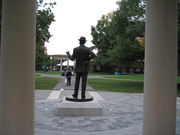
Students often congregate outdoors during the warmer months on the various quads. Other centers of student life include Todd Union, Frederick Douglass Dining Center, various locations inside Rush Rhees Library, and Wilson Commons, a student union designed by the architectural firm of I.M. Pei. Many academic buildings, including Rush Rhees Library, are connected by a series of tunnels,[13] which are used extensively, especially during unfavorable weather. Most academic buildings and common areas, as well as Freshman residence halls, have authenticated Wi-Fi internet access.[14]
Other campuses
- University of Rochester Medical Center
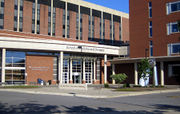
The University of Rochester Medical Center (URMC) is the primary campus for the university's medical education and research as well as the main patient care facility. The Medical Center is located adjacent to the River Campus and is dominated by Strong Memorial Hospital, the School of Medicine and Dentistry building and the Arthur Kornberg Medical Research Building. URMC also houses the School of Nursing and a variety of research centers, including the Wilmot Cancer Center, the Aab Institute of Biomedical Sciences, and an under-construction Clinical and Translational Sciences Institute.
- Eastman School of Music
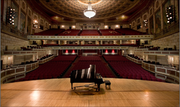
The Eastman School of Music is situated on its own campus in downtown Rochester, which includes a residence for students, classroom and performance facilities, and the Eastman Theatre, a 3,094-seat concert hall which also serves as the primary venue of the Rochester Philharmonic Orchestra. The campus also features the Sibley Music Library, which is the largest academic music library in North America, as well as the largest privately owned collection of sheet music. Students are housed at 100 Gibbs Street, a dormitory building constructed in 1991.
- South Campus
The South Campus is located in Brighton, NY, immediately south of Rochester proper. The campus includes the Laboratory for Laser Energetics, the Center for Optics Manufacturing, the Center for Optoelectronics and Imaging, and the now defunct Nuclear Structure Research Laboratory (NSRL). Graduate student housing is also provided at the Whipple Park complex.
- C.E.K. Mees Observatory
- Memorial Art Gallery
- Mount Hope Campus
Academics
University of Rochester's undergraduate enrollment consists of about 4,500 full-time and about 100 part-time students from across the U.S. and over 90 countries.[15] Graduate enrollment comprises about 3,300 full-time and about 550 part-time graduate students. The university has more than 97,000 living alumni. The university employs more than 1,200 tenure-track faculty, with more than 17,000 faculty and staff across the university and the Strong Health System. UR's faculty include fellows of all four National Academies of the U.S., Guggenheim Fellows, and recipients of many other awards and recognitions.[16]
The defining feature of the undergraduate program at the University is the Rochester Curriculum. There are no required subjects outside of a prerequisite writing course, which may be tested out of. The Curriculum requires that undergraduates study in all of three areas of knowledge: humanities, social sciences, and natural sciences. Aside from the area of study which a student's major falls in, undergraduates must complete 3-4 courses of related materials (called "clusters") within each of the remaining areas. For example, a student with a concentration in mathematics, a natural science field, must complete at least one cluster in the humanities and one in social sciences. A second concentration or a minor also satisfies this requirement. The only exceptions are students concentrating in an accredited engineering field (biomedical engineering, chemical engineering, electrical and computer engineering or mechanical engineering), who are only required to have one cluster in either humanities or social sciences.
The University of Rochester is known for its several unique 5th year programs. Students may apply for the Take Five Scholars program, a tuition free 5th year of study in a field of interest unrelated to their undergraduate major. The university also offers a Kauffman Entrepreneurial Year (KEY) Scholarship, a tuition-free 5th year of study offered to those with an innovative and unique entrepreneurial project impacting the campus or Rochester community. Both programs can be competitive and students may apply during their junior or senior year.[17][18]
Various other scholar programs exist for UR students, including the highly selective Rochester Early Medical Scholars (REMS) and Rochester Early Business Scholar (REBS) programs. Students must apply for these prior to entering the university.[19]
Rankings
UR is one of the 25 New Ivies in the 2007 Kaplan/Newsweek "How to Get into College Guide."[20] The list names institutions whose caliber of students is considered to rival traditional Ivy League schools.[20] The rankings are based on admissions statistics as well as interviews with administrators, students, faculty, and alumni.[21]
U.S. News and World Report, in their popular National University Rankings, placed the University of Rochester 35th in the nation for 2008, 2009, and 2010.[22] In 2007, the London Times rated the University of Rochester 48th among the best universities in the world and 21st among American educational institutions. The University of Rochester also placed 21st on The Washington Monthly College Rankings list. University of Rochester places within the top 10 for the staff-to-student ratio.[23] The University has also been ranked as 34th worldwide according to Global University Ranking[24] and 21st in the United States among research universities.
The Eastman School of Music ranks first among graduate music programs in the U.S.[25] Other schools in the university also rank highly, with the School of Medicine and Dentistry at 30th overall among medical schools and its primary-care program ranked 15th among primary-care medical schools, and the Simon School ranked 23rd among graduate business schools. U.S. News and World Report also ranked the Hajim School of Engineering's graduate program 38th nationally. Additionally, the graduate programs of political science, economics, and medical research were ranked 15th, 22nd, and 31st in the nation, respectively.[26][27]
For more information on University of Rochester's history and distinctions, please go to: http://www.rochester.edu/aboutus/history.html
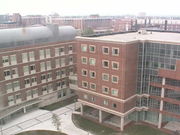
Research
UR is a leading private university and a major center for diverse fields of research. The university has eight Nobel Prize winners among its faculty and alumni. UR consistently ranks among the top 40 colleges and universities nationwide in federally financed science, engineering, medical, and other research, with a total research budget of around $350 million spread across many departments and research centers, including the Laboratory for Laser Energetics, a laser-based nuclear fusion facility, and the extensive research facilities at the University of Rochester Medical Center. Recently, the university has also engaged in a series of new initiatives to expand its programs in biomedical engineering and optics, including the construction of the new $37 million Robert B. Goergen Hall for Biomedical Engineering and Optics on the River Campus.[28] Other new research initiatives include a cancer stem cell program and a Clinical and Translational Sciences Institute.[29][30] UR also has the ninth highest technology revenue among U.S. higher education institutions, with $30 million being paid for commercial rights to university technology and research in 2005.[31] Notable patents include Zoloft and Gardasil. WeBWorK, a web-based system for checking homework and providing immediate feedback for students, was developed by University of Rochester professors Gage and Pizer. The system is now in use at over 100 universities and colleges.
Organization
Academics at the University of Rochester are generally organized and administered by school. The various departments offer degree programs ranging from certificates and bachelors degrees to doctorates.
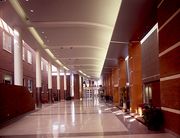
- The College of Arts, Sciences, and Engineering
- The College offers undergraduate and graduate education in large number of fields and encompasses the majority of undergraduate and graduate enrollment at the university. It is composed of The College of Arts and Sciences and the Hajim School of Engineering. The College is primarily located on the River Campus.
- Eastman School of Music
- The Eastman School of Music is a premier music institution offering both undergraduate and graduate education in a broad range of fields, including composition, theory and performance.
- Margaret Warner Graduate School of Education and Human Development
- The Warner School is the university's primary graduate school for education. It is located on the River Campus.
- School of Medicine and Dentistry
- The School of Medicine and Dentistry is a top rated graduate school that prepares students in medical, dental and research disciplines. The school is located in the University of Rochester Medical Center.
- School of Nursing
- The university also includes an accredited School of Nursing, located on the campus of the University of Rochester Medical Center.
- William E. Simon Graduate School of Business Administration
- The Simon School is a nationally ranked business school located on the River Campus.
Student life

UR's official symbol is the seal of the university, which features a book, representing arts and sciences, a lyre symbolizing music, and a modified symbol of medicine.[32] The official flower of the university is the dandelion, purportedly prolific on the cow pasture that became the university's first campus.[33]
The mascot is the Yellowjacket. From 1983 to 2008, it was named "URBee". However, when the university re-designed the mascot during the 2007-2008 academic year, a new name was chosen and as of February 1, 2008, the school's mascot has since been known as "Rocky"[34][35].
The university uses Dandelion Yellow and a shade of blue (Rochester blue) as its official colors, which are the prominent colors on the official regalia.[36]
The motto of UR is Meliora, which loosely translates to "better" with the connotation of "ever better", the meaning adopted by the university.[37]
The image of Rush Rhees Library's main dome serves as an additional icon for the University of Rochester.
UR also has official logos for the university as a whole as well as individual units, including The College, URMC and Eastman. President Seligman, as part of his efforts to improve UR's external appearance, commissioned Bill Murphy, the Vice President of Communications, to start an initiative to develop a new graphic identity, including a new logo, in hopes of improving uniformity and overall usage of official standards.[38] During March 2007, the communications office was soliciting opinions and comments on finalist designs for the new logo, which was unveiled later that fall.
The song most often sung at college events, led often by the school's many a cappella groups, is The Genesee. Although less frequently used, the university also has an official Alma Mater, The Dandelion Yellow.[39]
Traditions
UR features several traditional events throughout the year with diverse history.[40][41][42][43]
- ArtAwake brings students and community members together for a day of art and music.
- The Boar's Head Dinner began in 1934 and continues as an annual event.
- Convocation celebrates the start of the academic year and provides the opportunity for students, faculty, and staff to come together. The ceremony opens with a processional by faculty and administrators in traditional regalia, features presentation of the Goergen Awards for contributions to undergraduate education, and is accompanied by a picnic, activities fair and performances.
- Dandelion Day, colloquially known as D-Day, is a day late in the spring semester that was established as an annual respite around final exams with extensive celebrations, often accompanied by a carnival and musical guests. Previous years have featured Reel Big Fish, Eve 6, Talib Kweli, and Big Bad Voodoo Daddy. OK Go performed in 2010. During 2007, the administration suspended its support for D-Day. As of the Spring of 2009, the SA once again sponsors D-Day
- Mela is an annual celebration held late in the spring semester celebrating Indian culture and dance. The tradition has been a significant showcase for the University and Rochester Community since 1986.
- Meliora Weekend is celebrated in early October during a weekend around the University anniversary, combining class reunions, homecoming, family weekend, and a regatta. Past speakers include Anderson Cooper, Stephen Colbert, Colin Powell, and United States Secretary of Energy and University of Rochester alumnus Steven Chu.
- A Pillow Fight occurs annually on the academic quad at the conclusion of the spring semester .
- Wilson Day is day of community service for all incoming university students which include working on neighborhood picnics, voter registrations, painting, landscaping, meal service, and various other service efforts in the community.
- Winterfest Weekend takes place early in the second semester and helps celebrate the snowy Rochester winters. Highlights of the weekend include comedic performances (previous comedians include Demetri Martin, B.J. Novak and Michael Ian Black), sleigh rides and ice skating.
- Yellowjacket Weekend occurs at the beginning of the fall semester and is a celebration of school spirit culminating in a football game with crosstown rival St. John Fisher College.
Student organizations
The student body at the University of Rochester is both ethnically and socioeconomically diverse. There are over 200 active Students' Association recognized groups on campus, which range from cultural dance groups such as UR Bhangra to U of R's comedy improv troupe In Between the Lines[44]. Since 1893, the University has regularly printed its student newspaper, the Campus Times.[45] Several a cappella groups, notably the Midnight Ramblers and YellowJackets, play a prominent role in campus life. The University of Rochester is also home to its own radio station, WRUR.
Residences
The majority of undergraduate students at the university live and take classes on the River Campus. Underclassmen are generally required to live on campus while upperclassmen have the option to live off campus. Some graduate housing is provided by the university, but a significant number also live off campus. Housing is provided at multiple locations spread across the several campuses.[46]
River Campus River Campus residences house primarily undergraduates, with some graduate students serving as Graduate Head Residents (GHRs). Residences include:
- Fraternity Quad - Made up of nine houses. Seven fraternities (Alpha Delta Phi, Delta Kappa Epsilon, Psi Upsilon, Sigma Alpha Mu, Sigma Chi, Delta Upsilon, and Theta Chi) and two special interest housing groups (Community Learning Center and Drama House) maintain housing here. Psi Upsilon is currently disaffiliated from the university, and the house will remain empty until 2013. [47]
- Freshman Housing - Consists of Susan B. Anthony Halls (Gannett, Gates, Hollister, and Morgan), located near Rush Rhees Library, Hoeing Hall, Tiernan Hall, and Gilbert Hall, which are located on the Residence Quad. Freshmen live together in these specially designated residences that feature increased supervision, regulation, and residence-related activities by upperclassmen Dandelions (affectionately known as D'Lions) and Freshman Fellows, along with Residential Advisers in living areas.
- Hill Court - Upperclass housing consisting of Chambers, Fairchild, Gale, Kendrick, Munro, and Slater houses, which are connected by underground tunnels. This residence area, opened in 1969, is colloquially known as "Phase" and was the newest residential area on the River Campus prior to the construction of the Riverview Complex.
- Residence Quad (ResQuad) - Consists of Burton, Crosby, Lovejoy, and Tiernan Halls for upperclassmen, as well as Hoeing and Gilbert Halls for freshmen. Burton and Crosby were the original dormitories on the River Campus, constructed in 1930, while the other four were built during the 1950s. All ResQuad buildings were fully renovated in the 1990s.
- River Campus Towers - Consists of Anderson and Wilder Towers and houses upperclassmen and several Special Interest Housing groups. The formal name for the area is Founders Court, but it is simply called "Towers" by most students. Built in 1962, they are scheduled to undergo extensive renovations in the near future.
- Southside / Graduate Living Center (GLC) - Colloquially known GLC - pronounced "glick", Southside consists of Valentine and deKiewiet Towers, as well as several "maisonettes", which offer apartment style living to upperclassmen. The residences tend to serve as overflow space for student housing. The residences are located south of the River Campus near the medical center, but house River Campus undergraduate students. The campus master plan shows that this complex will eventually be razed.
- Riverview - The only housing complex on the western side of the Genesee River, Riverview is the newest housing complex for the campus, opening for the 2008-2009 school year, making it the first addition to the campus's housing in nearly 40 years. The complex consists of five buildings, which can house up to 400 people, approximately 250 of which will be undergraduates in its first year, with plans to make it entirely undergraduate housing as the University expands. The complex is made up of fully furnished two-to-four person apartments.
Special Interest floors and Fraternity floors also exist within the residence halls. Special Interest Housing groups include the International Living Center (ILC), Interclass Living Center (ICLC - Crosby 1), Music Interest Floor (MIF - Wilder 9), Health and Home (Valentine 6), Computer Interest Floor (CIF - Anderson 3), Tiernan Project (Burton 2), Media Living Center (MLC - Anderson 7), Film Interest Floor (FIF - Kendrick 1) and Anime Interest Floor (AIF - Anderson 7).
Eastman School of Music Campus Housing is provided at the Eastman School of Music campus at the Eastman Student Living Center at 100 Gibbs Street in downtown Rochester. The new building was opened in 1991 at the northeast corner of Main and Gibbs Streets, replacing the University Avenue dormitories built nearly 70 years earlier. It is a four-story quadrangle and 16-story tower surrounding a landscaped inner courtyard.
URMC and Mount Hope Campuses Graduate student housing is provided at 4 locations near the URMC and Mount Hope.
- George Washington Goler House (GHS) immediately adjacent to the grounds of the URMC. It is a high rise apartment building with 321 apartments. The building also houses university community members, including faculty and staff.
- University Towne House (UTH) is a group-living style, two story building located on the Mount Hope Campus with 60 studios. The building is adjacent to Mount Hope businesses as well as university offices.
- University Park (UPK) is a complex of two story buildings that include 40 studio, 86 one-bedroom, and 80 two-bedroom unfurnished apartments. UPK is located near the URMC off of Kendrick Road.
South Campus The South Campus has graduate student housing at the Whipple Park (WPK) complex, which features 250 garden apartments and townhouses with ample storage space. WPK also features a park-like setting with large wooded and lawn areas, playgrounds, areas for gardens and low street noise. Some housing is also provided at the River Road complex, which tends to serve as overflow housing for both undergraduate and graduate students.
Students' Association

The Students' Association (SA) is the primary student governing body and includes most of the student groups at UR. The SA is governed by the SA Senate, President and Vice President, all of whom are elected by the student body. The SA President is advised by a cabinet, which is a volunteer group of students. There is also a judicial branch, composed of the All Campus Judicial Council (ACJC), the members of whom are nominated by an interview committee and approved by the SA Senate. The offices of the SA are located in the Wilson Commons student union.[48]
All student groups are required to have a constitution, elected officers, and approval from senate in order to be recognized by the SA and have access to university funds. These funds are given yearly based on budgets submitted to the Students' Association Appropriation Committee (SAAC)[49] with supplemental funds available through special forms. All funds are derived from the mandatory Student Activities Fee.
Athletics
UR's athletics teams are called the Yellowjackets. They participate in the Division III of the NCAA and in the University Athletic Association and Liberty League. One exception to this is the men's squash team, which plays in Division I.[50] The University fields men's teams in baseball, basketball, cross country, football, golf, soccer, swimming and diving, tennis, and track and field. On the women's side, UR sponsors teams in basketball, cross country, field hockey, lacrosse, soccer, softball, swimming and diving, tennis, track and field, and volleyball.
In 2009 women's soccer coach Terry Gurnett set records with over 400 lifetime wins.[51][52] In March 2010 the women's basketball team made it to the NCAA's Final Four.
There are also numerous club and intramural athletics groups.
The main athletics facilities of the university are in the Robert B. Goergen Athletic Center and Fauver Stadium on the River Campus, with other facilities located in the Spurrier building (River Campus) and the URMC.[53][54]
Campus and area transportation
The UR campuses have their own University-sponsored system of buses, or shuttles, which provide free transportation from the River Campus to the Medical Center, South Campus, Eastman Campus, and Riverview. There are also lines that run between the River Campus and local shopping and entertainment in Henrietta and Pittsford. On the weekends, a shuttle loops to the Rochester Public Market, a student favorite. Most of the University-sponsored buses are named using a color system (i.e. Red Line) that indicates their respective route and allows for easy identification. Several bus lines of the Rochester-Genesee Regional Transportation Authority (RTS) also make stops at the University.
The university participates in the Zipcar program, which allows students to rent cars on an hourly or daily basis.[55][56]
The Greater Rochester International Airport is a ten-minute drive to the west of the River Campus. In addition, Amtrak train and Greyhound bus have stations in downtown Rochester to the north of the campus.
Notable alumni and faculty
See also
- George Eastman House
- Memorial Art Gallery
- University of Rochester Arboretum
- University of Rochester Medical Center
References
- ↑ :: USNews
- ↑ The Eastman School campus is in downtown Rochester (urban), while the majority of the university is located in a more suburban environment.
- ↑ Rochester.du, UR Publications Services: Graphics Standards University Colors
- ↑ State.NY.us, New York State Department of Labor: Workforce Industry Data
- ↑ History of the University of Rochester
- ↑ May, Arthur J. (1977) A History of the University of Rochester, Princeton: Princeton University
- ↑ 7.0 7.1 May, Arthur J. (1977) A History of the university of Rochester, Princeton: Princeton University
- ↑ University of Rochester: History and Distinctions
- ↑ Rochester.edu, Press Release: Rochester Renaissance Plan for The College
- ↑ University of Rochester News Release: University Names New Trustees and New Chairman
- ↑ University of Rochester: Presidents of the University
- ↑ Interactive Map of the River Campus
- ↑ Rochester.edu, tunnels
- ↑ UR Wireless Coverage
- ↑ Diversity at Rochester, Office of Admissions
- ↑ Faculty and Students at UR
- ↑ Take Five Scholars Program
- ↑ KEY Program
- ↑ Combined Admissions Programs
- ↑ 20.0 20.1 Newsweek Web Exclusive (August 21, 2006). "25 New Ivies". Newsweek. http://www.newsweek.com/id/39401/page/4. Retrieved 2009-08-27.
- ↑ America's 25 New Elite 'Ivies' - Kaplan College Guide
- ↑ USNews.com: America's Best Colleges 2008: National Universities: Top Schools
- ↑ Times Higher Education Top Tens
- ↑ GlobalUniversityRanking.org
- ↑ Rochester.edu
- ↑ Rochester.edu
- ↑ USnews.com, U.S. News & World Report College Rankings
- ↑ Press Release: Funding for New BME Building
- ↑ URMC Press Release: Wilmot Launches Cancer Stem Cell Research Program
- ↑ URMC: The New Clinical and Translational Sciences Institute
- ↑ Association for University Technology Managers: FY2005 U.S. Licensing Survey
- ↑ University of Rochester Seal
- ↑ University of Rochester: Dandelion
- ↑ University of Rochester Mascot: The Yellowjackets
- ↑ New University of Rochester Yellowjacket to debut Feb. 1
- ↑ University of Rochester Colors
- ↑ Meliora Weekend: FAQ
- ↑ Rochester Review: Interview with Bill Murphy]
- ↑ Songs of the University of Rochester
- ↑ UR Traditions, Events and Entertainment
- ↑ ArtAwake
- ↑ Mela
- ↑ Pillow Fight
- ↑ Student Groups
- ↑ Campus Times publication
- ↑ University of Rochester Residential Life
- ↑ | Title = Local Frat Accused of Drinking And Hazing
- ↑ SA Student Government
- ↑ Rochester.edu
- ↑ UR Athletics
- ↑ "Rochester coach becomes third 400-game winner". National Collegiate Athletic Association. September 14, 2009. http://www.ncaa.org/wps/ncaa?key=/ncaa/ncaa/ncaa+news/ncaa+news+online/2009/division+iii/rochester+coach+becomes+third+400-game+winner_09_14_09_ncaa_news. Retrieved 2009-11-13. "Rochester’s Terry Gurnett became only the third women’s soccer coach in any NCAA division, and the first in Division III, to win 400 games in the sport. He reached the milestone Friday in the Yellowjackets’ 1-0, sudden-death overtime victory over Penn State Behrend."
- ↑ "UR's Gurnett secures 400th win". Rochester Democrat and Chronicle. September 12, 2009. http://pqasb.pqarchiver.com/democratandchronicle/access/1857811391.html?FMT=ABS&date=Sep+12,+2009. Retrieved 2009-11-13. "Terry Gurnett recorded his 400th win as the University of Rochester defeated Penn State-Behrend 1-0 in overtime Friday in the first round of the Clarion Hotel Women's Soccer Classic at Fredonia."
- ↑ UR Athletics Facilities
- ↑ URMC Fitness & Wellness Center
- ↑ "University of Rochester students, faculty, and staff can join Zipcar". zipcar. 2010-01-08. http://www.zipcar.com/rochester/. Retrieved 2010-01-08. "Members age 18-20 can use a dedicated group of Zipcars that live on campus..."
- ↑ "Zipcars". University of Rochester. 2010-01-08. http://www.rochester.edu/parking/zipcars.html. Retrieved 2010-01-08. "How Does Zipcar Work?"
External links
|
|||||||||||
|
|||||
|
|||||||||||
|
|||||
|
||||||||
|
|||||